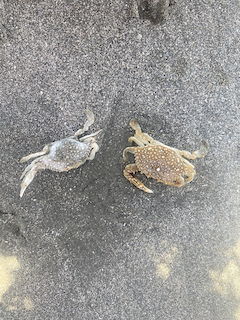Dead or molt?
Dead or Molt?
When exploring the beach and you come across what you may think is a dead crab it could actually be a molt or shed of the crab’s exoskeleton. Well, is it stinky or goopy? It is most likely dead, however, if the critter shell in question opens from the back side, is not stinky, and does not goop, it is a molt!
Much like cicadas and their molts, crabs and other arthropods discard their rigid exoskeletons to grow! Since their exoskeletons do not expand, crabs must periodically shed these shells to increase in size. Molting is crucial for crabs as it allows them to grow, regenerate lost limbs, and even remove parasites. For juvenile crabs, frequent molting is necessary for rapid growth. Adult crabs, on the other hand, molt less frequently, primarily for maintenance and repair.

Molt (left) and soft shell speckled swimming crab (right)
When the crab is ready to molt its exoskeleton it backs its body out of its shell–the crab is vulnerable until it regrows its new hard shell which can take three to four days!

Soft shell blue crab (left) and molt (right).
